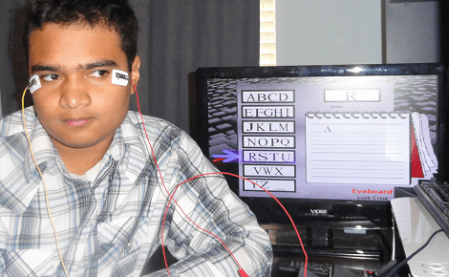
[Luis Cruz] is a Honduran High School student, and he built an amazing electrooculography system, and the writeup (PDF warning) of the project is one of the best we’ve seen.
[Luis] goes through the theory of the electrooculogram – the human eye is polarized from front to back because of a negative charge in the nerve endings in the retina. Because of this minute difference in charge, a user’s gaze can be tracked by electrodes attached to the skin around the eye. After connecting eye electrodes to opamps and a microcontroller, [Luis] imported the data with a Python script and wrote an “eyeboard” application to enable text input using only eye movement. The original goal of the project was to build an interface for severely disabled people, but [Luis] sees applications for sleep research and gathering marketing data.
We covered [Luis]’ homebrew 8-bit console last year, and he’s now controlling his Pong clone with his eye-tracking device. We’re reminded of a similar system developed by Atari, but [Luis]’ system uses a method that won’t give the user a headache after 15 minutes.
Check out [Luis] going through the capabilities of his interface after the break.
[youtube=http://www.youtube.com/watch?v=JlgKOV_mn18&w=470]















Brilliant! This seems like a perfect solution for eye-tracking in a head-mounted unit (where a camera seems too in-the-way).
Wow, this kid will set the world on fire. Nice work.
Pretty bloody clever.
Excellent idea, but the python code makes me cry so much
Out-facking-standing.
See what happens when kids are sent to REAL schools where they actually teach stuff?
The best you can expect from an American HS student is a complete sentence or two about how sensitive they are to social issues.
It’s always great to see new tech innovations come out–especially from young folks. Does Luis intend to take this open source, commercialize it, or…?
He should hook it up to Dasher: http://www.inference.phy.cam.ac.uk/dasher/
Nothing less than extraordinary. Not to take anything from Luis, that’s why to comparison to American HS students could be seen coming from 10 miles away. I could rattle on about that. I’ll simply caution about using about using to broad a brush, and suggest anyone who never sees excellence in American HS students, just may be due to that birds of a feather flock together?? There; I gave an example of a broad brush. ;) Hopefully those who can afford to do so, will go to Luis’s page and use the donate feature.
He should of done the eye mario like waterloo labs did with LabView.
http://www.youtube.com/watch?v=4j2kw5MJK24
Not quit new idea, but good job to Luis.
The idea if implemented in a pair of eyeglasses wireless (bluetooth) hooked up to a PC+Display could help severely disabled people.
The eyeglasses’ frame should incorporate the electrods and data acquisition circuitry for a compact and portable design.
That’s fantastic work, especially considering his age!
Just to dump more related info:
James Gips of Boston College developed an EOG system called Eagle Eyes, which is actually distributed (usually free of charge I believe) to people who need it. (http://www.eagleeyes.org/)
I built an EOG controlled wheelchair over the course of my senior design and master’s thesis projects. (http://www.gavinphilips.com/projects/eyecontrolledwheelchair)
As I mentioned on my website, VOG (videooculogram) systems have made more progress, including the communication devices from Tobii, Dynavox, etc.
Finally, Jason Babcock built an IR VOG system into a pair of glasses fairly cheaply, and he’s the open source type. (http://www.jasonbabcock.com/eyetracking.html)
Can anyone tell me the difference between eagle eyes and Luis’s system? Also trying to get some kind of system setup for GBS patient in intensive care unit. What system is better electrode eye tracking or infrared eye tracker?
In a clinical setting, I have only seen infrared/camera based systems used. They are probably the most effective and reliable.
Each AAC (augmentative alternative communication) company has one. Our speech therapists seem to prefer the Dynavox EyeMax and the Tobii systems.
Updated link for the PDF file:
http://www.trycz.com/wp-content/uploads/2012/08/eyeboard.pdf